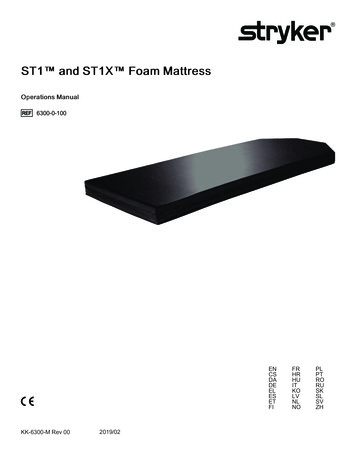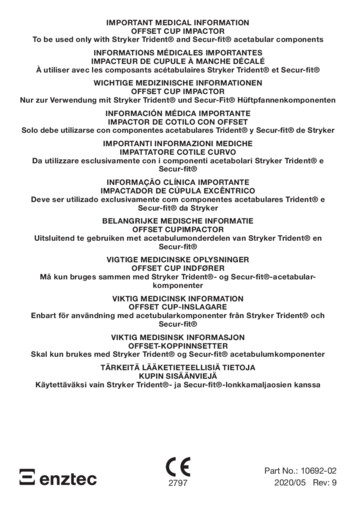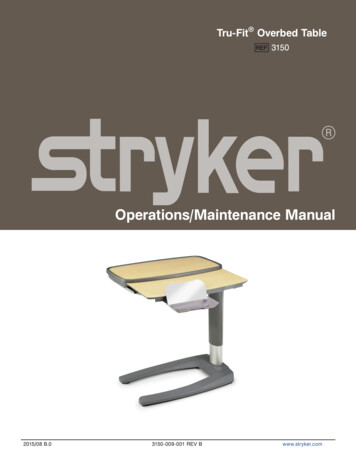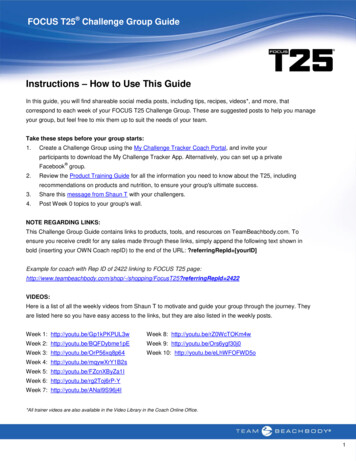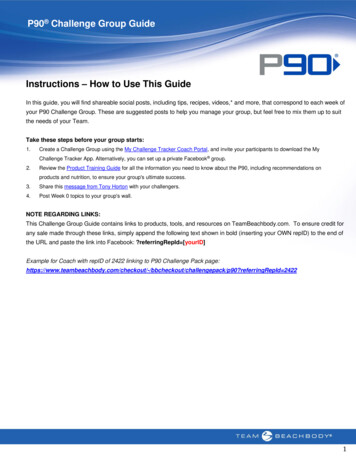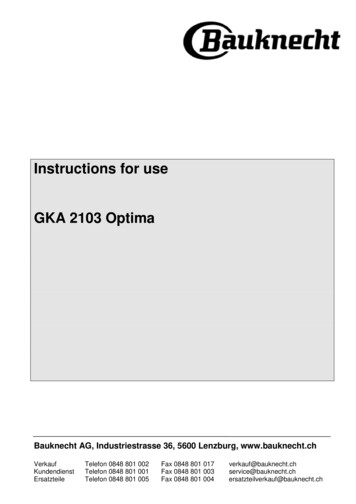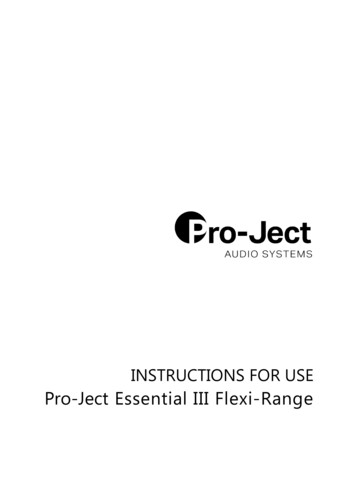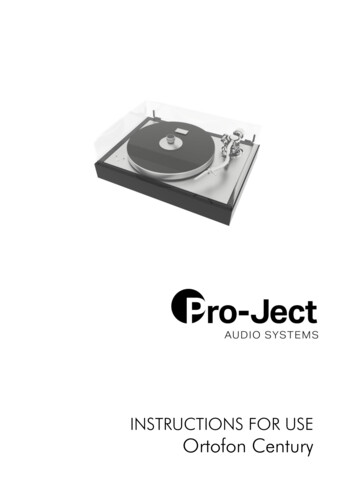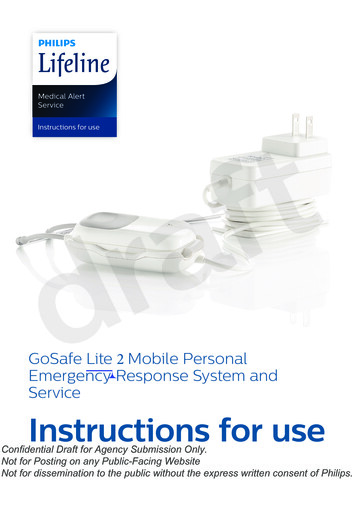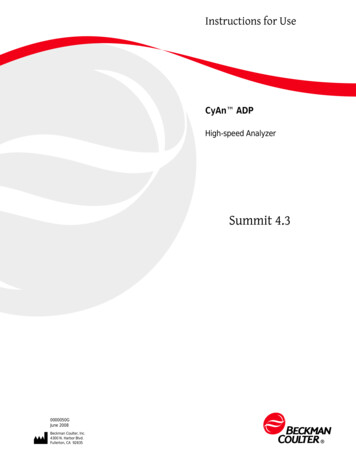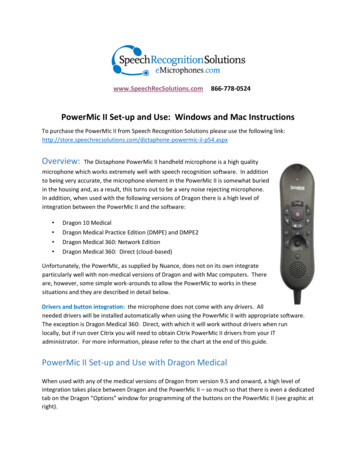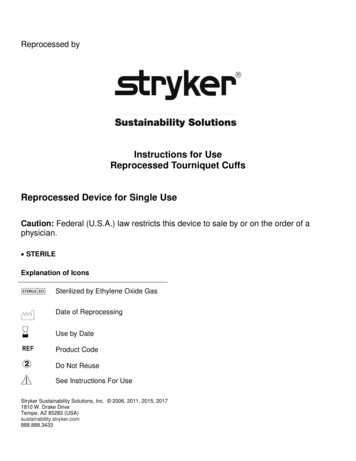
Transcription
Reprocessed byInstructions for UseReprocessed Tourniquet CuffsReprocessed Device for Single UseCaution: Federal (U.S.A.) law restricts this device to sale by or on the order of aphysician. STERILEExplanation of IconsSterilized by Ethylene Oxide GasDate of ReprocessingUse by DateProduct CodeDo Not ReuseSee Instructions For UseStryker Sustainability Solutions, Inc. 2006, 2011, 2015, 20171810 W. Drake DriveTempe, AZ 85283 (USA)sustainability.stryker.com888.888.3433
Reprocessed Tourniquet CuffsTourniquet Cuff DescriptionTourniquet cuffs are single- or dual-bladder inflatable cuffs connected to a tourniquet system via a hose assembly. Whenwrapped around a limb and inflated, tourniquet cuffs apply an adequate amount of pressure on the arterial blood flow in alimb to create a bloodless surgical field. Tourniquet cuffs are available in a variety of sizes to accommodate a wide rangeof limb circumferences.Indications for UseReprocessed tourniquet cuffs are indicated for use in patients who require surgery of the extremities with an expectedduration of less than 90 minutes when temporary exsanguination of a limb is desired.Contraindications for UseReprocessed tourniquets are contraindicated for the following: Open fracture of the leg Prolonged hand reconstruction surgery Severe crushing injuries Elbow surgery with concomitant swelling Severe hypertension Skin grafts Compromised vascular circulation Diabetes mellitusNote: Sickle cell disease is a relative contra-indication. Patients with hemoglobin S should be closely monitored usingblood pO2 and pH testing when a tourniquet is in use.Warnings These devices are only intended for use by individuals with adequate training and familiarity with tourniquet use. Forfurther information about techniques, complications and hazards, consult the medical literature. It is important that the tourniquet cuff be applied at the proper location with adequate pressure for the appropriateamount of time. Follow established tourniquet use procedures. DO NOT use the limb protection sleeve more than once. Failure to comply may result in patient injury. Placing the tourniquet over the peroneal or ulnar nerve can cause nerve damage or paralysis. To avoid damage to the underlying tissue from shearing forces, do not rotate the tourniquet cuff when adjusting itsplacement. Avoid needles, towel clips, leg holders and other equipment that can puncture or otherwise damage the cuff. Never use the tourniquet cuff to control distention medium gases. To prevent intraoperative bleeding avoid the following:o underpressurizing the cuffo insufficient exsanguinationo excessively slow inflation and deflationo poor tourniquet pressurePrecautions When a tourniquet cuff is used, patients with sickle-cell disease or trait may experience severe postoperative pain andworsening of their overall condition. When using an elastic bandage for exsanguination, leave approximately 1 inch (2.5 cm) of uncovered skin betweenbandage and tourniquet cuff. Avoid using an elastic bandage:o In the presence of infections or painful fractures.o Post cast removal.o When this could result in the distribution of bacteria, exotoxins, malignant cells and thrombi to the generalcirculation.o Instead, elevate the limb for 3 to 5 minutes. Preoperative skin preparations should not be applied to the area under the tourniquet cuff. Inflate the tourniquet cuffs quickly for the simultaneous occlusion of arteries and veins as well as the prevention ofblood return into the limb. Deflate rapidly to prevent enlarged or swollen areas. Avoid heat from light and other sources. Avoid prolonged ischemia and prolonged tourniquet time to prevent serious conditions like tourniquet paralysis and
Reprocessed Tourniquet Cuffs pooling of blood in the edemic limb.Do not reapply a tourniquet cuff to a limb with no or insufficient exsanguination.If a tourniquet cuff must be reapplied, ensure that it is fully deflated first.Remove tourniquet cuff from limb immediately after final deflation.When applying the cuff, ensure that it is smooth and unwrinkled to prevent possible blistering or tissue damage.Always route the tourniquet cuff and fill line tubing away from traffic areas to avoid tube damage and a trippinghazard. Failure to comply may result in patient and/or healthcare staff injury.Apply pressure dressings and elevate the limb as necessary to protect the operative site from blood resurgence whencuff pressure is released.Immediately following final tourniquet deflation, remove the cuff and all underlying padding to avoid slowing of venousreturn and resulting blood pooling at the operative site.Users should be familiar with the inflation/deflation sequence and use care when using a dual-bladdered cuff or twosingle-bladdered cuffs together. Release of the incorrect bladder or cuff could cause severe injury or death.When using infiltration anesthesia, published literature suggests keeping the cuff inflated for at least 15 minutes afterinjection of the anesthetic agent to ensure that the agent has been adequately absorbed by limb tissues. If theprocedure itself is less than 15 minutes long, rapid deflation and re-inflation of the cuff may keep the agent from beingprematurely released and allow its absorption into surrounding tissue.Adverse Reactions Tourniquet pain throughout the limb Limb stiffness Limb weakness Reactive hyperemia Skin discoloration Motor paralysis Vascular complications Ischemia Deep vein thrombosis Venous emboli or thromboembolism Blood vessel trauma Reperfusion problems and arterial occlusion Loss of sense of touch, pressure and other stimuli response Death, specific to the Bier Block procedure.Directions for Use1. Before beginning the procedure, verify compatibility of all devices and accessories.2. Inspect the device and package before opening. The contents of the package are sterile if the packaging has notbeen compromised.3. Do not attempt to resterilize.4. If the package is damaged or if it was opened and the device was not used, return the device and packaging toStryker Sustainability Solutions.5. Remove the device from the package and place it in a sterile work area using aseptic technique.6. Inspect the device for overall condition and physical integrity. Do not use the device if any damage is noted. Returnthe device and packaging to Stryker Sustainability Solutions if it is not in acceptable condition for surgery.7. Prior to surgery, select the proper sized tourniquet cuff and limb protection sleeve by measuring the circumference ofthe patient’s limb. This will avoid problems caused by a tourniquet cuff and limb protection sleeve that is too small ortoo large.8. Prior to application, wrap the area with a limb protection sleeve, avoiding any wrinkles in the sleeve.9. Wrap the cuff around the patient’s limb, aiming for a snug and secure fit without wrinkles.10. Position the tubing so that it cannot be kinked, which could cause airflow interruption.11. Secure the cuff fasteners to ensure that the cuff stays in place during the procedure.12. Connect the tourniquet cuff to the tourniquet controller. Refer to the tourniquet controller manual for usageinstructions.13. Prepare and drape the limb for surgery.14. Avoid liquid skin preparations that can flow under the tourniquet cuff.15. Verify that the limb tissue is viable prior to exsanguinating the limb and inflating the tourniquet.16. Use an elastic bandage and follow a suitable protocol to exsanguinate the limb.17. Follow a suitable tourniquet application protocol.
Reprocessed Tourniquet Cuffs18. Use the minimum effective pressure setting.19. Follow established surgical guidelines to determine inflation, duration of procedure, pressure setting, timing of inflationand timing of release.20. Follow accepted surgical guidelines for cuff removal.21. Follow accepted surgical guidelines for anesthetic agent usage.22. Device is intended for multiple uses during a single patient procedure. Return to Stryker Sustainability Solutions forreprocessing or discard after use.
Reprocessed Tourniquet CuffsWarrantyReprocessed ProductsStryker warrants all reprocessed products, subject to the exceptions provided herein, to be free from defects inreprocessing and to substantially conform to the product specifications contained in the documentation provided byStryker with the products for one use in accordance with the instructions for use of such product.STRYKER SHALL NOT BE LIABLE FOR ANY DAMAGES TO THE EXTENT CAUSED BY ANY DEFECT INMATERIAL, WORKMANSHIP OR DESIGN BY THE ORIGINAL MANUFACTURER OF THE PRODUCT OR ANY ACTOR OMISSION OF THE ORIGINAL MANUFACTURER OF THE PRODUCT.Products for which Stryker is the Original ManufacturerStryker warrants all products for which it is the original manufacturer, subject to the exceptions provided herein, to be freefrom defects in design, materials and workmanship and to substantially conform to the product specifications contained inthe documentation provided by Stryker with the products for a period of one year from the date of purchase.General Warranty Terms Applicable to All ProductsTO THE FULLEST EXTENT PERMITTED BY LAW, THE EXPRESS WARRANTY SET FORTH HEREIN IS THE ONLYWARRANTY APPLICABLE TO THE PRODUCTS AND IS EXPRESSLY IN LIEU OF ANY OTHER WARRANTY BYSTRYKER, EXPRESSED OR IMPLIED, INCLUDING, BUT NOT LIMITED TO, ANY IMPLIED WARRANTY ORMERCHANTABILITY OR FITNESS FOR A PARTICULAR PURPOSE. IN NO EVENT WILL STRYKER’S LIABILITYARISING IN CONNECTION WITH THE SALE OF THE PRODUCT (WHETHER UNDER THE THEORIES OF BREACHOF CONTRACT, TORT, MISREPRESENTATION, FRAUD, WARRANTY, NEGLIGENCE, STRICT LIABILITY OR ANYOTHER THEORY OF LAW) EXCEED THE PURCHASE PRICE, CURRENT MARKET VALUE OR RESIDUAL VALUEOF THE PRODUCTS, WHICHEVER IS LESS. STRYKER SHALL NOT BE LIABLE FOR INDIRECT, SPECIAL,INCIDENTAL, PUNITIVE OR CONSEQUENTIAL DAMAGES RESULTING FROM ANY BREACH OF WARRANTY ORUNDER ANY OTHER LEGAL THEORY.This warranty shall apply only to the original end-user purchaser of products directly from Stryker or a Stryker authorizeddistributor. This warranty may not be transferred or assigned without the express written consent of Stryker.This warranty does not apply to: (1) products that have been misused, neglected, modified, altered, adjusted, tamperedwith, improperly installed or refurbished; (2) products that have been repaired by any person other than Strykerpersonnel without the prior written consent of Stryker; (3) products that have been subjected to unusual stress or havenot been maintained in accordance with the instructions in the user manual or as demonstrated by a Strykerrepresentative; (4) products on which any original serial numbers or other identification marks have been removed ordestroyed; or (5) products that have been repaired with any unauthorized or non-Stryker components.If a valid warranty claim is received within thirty (30) days of the expiration of the applicable warranty period, Stryker will,in its sole discretion: (1) replace the product at no charge with a product that is at least functionally equivalent to theoriginal product or (2) refund the purchase price of the product. If a refund is provided by Stryker, the product for which therefund is provided must be returned to Stryker and will become Stryker’s property. In any event, Stryker’s liability forbreach of warranty shall be limited to the replacement value of the defective or non-conforming part or component.If Stryker determines in its reasonable discretion that the claimed defect or non-conformance in the product is excludedfrom warranty coverage as described hereunder, it will notify the customer of such determination and will provide anestimate of the cost of repair of the product. In such an event, any repair would be performed at Stryker’s standard rates.Products and product components repaired or replaced under this warranty continue to be warranted as described hereinduring the initial applicable warranty period or, if the initial warranty period has expired by the time the product is repairedor replaced, for thirty (30) days after delivery of the repaired or replaced product. When a product or component isreplaced, the item provided in replacement will be the customer’s property and the replaced item will be Stryker’sproperty. If a refund is provided by Stryker, the product for which the refund is provided must be returned to Stryker andwill become Stryker’s property.The OEM information listed on the label is provided as device ID prior to reprocessing and may contain the trademarks of unrelatedthird parties that do not sponsor this device.
Reprocessed Tourniquet CuffsSterilization: This product and its packaging have been sterilized with ethylene oxide gas (EtO). Even though the product then isprocessed in compliance with all applicable laws and regulations relating to EtO exposure, Proposition 65, a State of Californiavoter initiative, requires the following notice:Warning: This product and its packaging have been sterilized with ethylene oxide. The packaging may expose you to ethyleneoxide, a chemical known to the State of California to cause cancer or birth defects or other reproductive harm.TQC Rev J 06-2017 RM702023
9. Wrap the cuff around the patient’s limb, aiming for a snug and secure fit without wrinkles. 10. Position the tubing so that it cannot be kinked, which could cause airflow interruption. 11. Secure the cuff fasteners to ensure that the cuff stays in p
